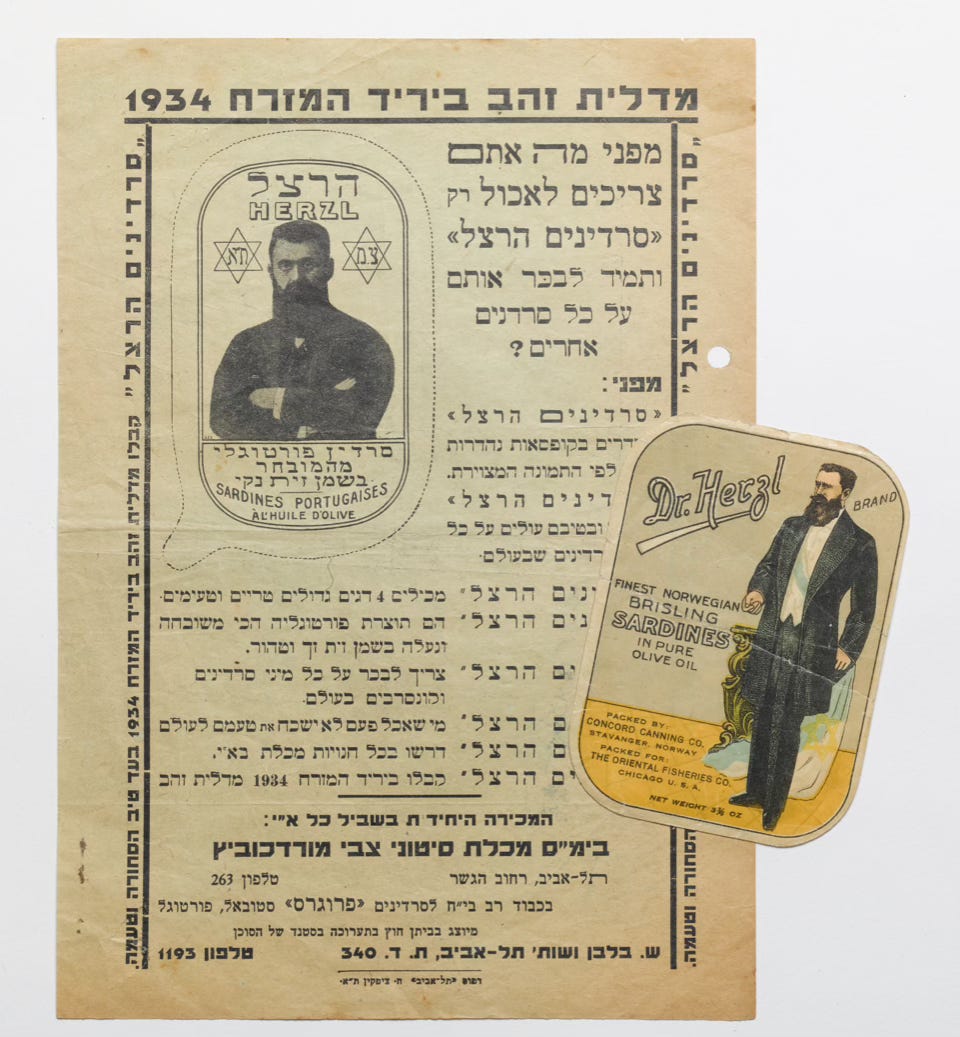Herzl's Sardine Tin
Or, the strange association between Jews & small fish
Tinned Fish is having a comeback. When one of my favourite cheftestants on Top Chef said that her “food dream” was having a boutique fish cannery, I laughed a bit. And not only has her business taken off, it’s far from the only one. There are high-end shops and restaurants around the United States and Europe, filled with boutique and small-batch canned fish. One of my favourite episodes of the Netflix show Somebody Feed Phil was when in Lisbon, he went to a store that only sells one product: tinned fish. (Note: the store is called Comur if you’re ever in Lisbon, and it was established in 1492). And very interestingly, that’s where the Jewish connection with the small fish — sardines, anchovies, whitebait, smelt, etc. — begins too.
In 1492, hundreds of thousands of Jews lived in Spain; it was one of the largest communities in Europe. Jews had achieved relatively high status and success under the Muslim Spanish leaders in the 8th century onwards, and at the very beginning of the Reconquista of Spain by European Christians (around the time of the Crusades) they stayed largely in favour. Because they were needed to communicate with the local population, of course. But as the conquistadors’ dependence on the Jews lessened, so too did Jewish status. In 1391, the so-called converso crisis began, when the Church-backed Isabella and Ferdinand gave many Jews a fundamental choice: convert or die. Even when this death-filled period ended, Jews were forced out of any positions of status in Spain, and as a result, many converted to Christianity to evade these restrictions. While many were legitimate converts, there were also a great many who became crypto-Jews, hiding their true religious beliefs behind an opaque love of Jesus. In total, some 200,000 converted.
Some in Spain became obsessive about finding out “secret Jews” — even going so far as to look through people’s windows on Friday nights to see if they were lighting Shabbat candles, or placing pork in various food products and examining the reaction of suspected Jews when they discovered it. And in 1478, the Inquisition began. Contrary to popular belief, it was not Jews who were being “inquisition-ed,” it was conversos who were suspected of maintaining an affiliation with the Jewish faith. They were dragged in, tortured in truly abominable ways, and often burned at the stake. And in 1492, the conversos were allowed to stay in Spain, but the Jews were not; something about having a Jewish community in plain sight keeping the conversos Jewish? In all, about 150,000 were expelled. Some went to the New World, some went to Poland, and many went to France and Italy.

But papal laws and restrictions followed them, as everywhere was formally Catholic in the 15th century. And one of those papal laws, particularly in Western Europe, was the restriction on the size of fish that Jews could buy. In Italy particularly, despite the fact that the Roman Jewish ghetto was on the Tiber and adjacent to the fish market, Jews were not permitted to buy anything other than scraps or small fish — particularly sardines and anchovies. And thus the particularly Jewish affiliation with small fish began.
When Jews began moving in big numbers to Eastern Europe, the Jewish-Fish connection continued and diversified. In Eastern Europe though, in addition to tinned sardines, they also began eating carp, whitefish and herring. And pickled herring became one of the #1 Jewish treats. While often associated with Ashkenazi cuisine, pickled herring was also a popular dish broadly in Eastern Europe, particularly in Poland, Ukraine and Russia. It also helped that these fish were actually quite healthy. When you have less access to abundant food sources, finding one that was both filling and good for you was an exciting thing. But perhaps it remains such a close association with Jews because of the Jewish dispersal to the New World, and the way that they brought pickled and salted fish that soon came to dominate the food scene in NYC’s Lower East Side.
When mass Jewish immigration began, it was often Russian Jews forced out by Alexander III’s May Laws in the 1880s. And along with Yiddish, poverty, and a long history of persecution and outsider-status that would prove useful as an immigrant, they brought pickled, salted and smoked fish. All along the streets of the Lower East Side, Jews would sell herring straight out of the barrel on the streets. It was cheap & cheerful, plentiful, and nutritious — exactly what hard-working and impoverished immigrants needed for their long days.
As their fortunes improved, many moved into dairy establishments called “appetizers” — the dairy equivalent of “delicatessens” which were meat-focused. One of them is the famous Russ & Daughters, which still stands today, albeit known now for smoked salmon more than anything else. In another blog post, I want to explore further about how “Jewish food” became the standard “New York food,” particularly delis and bagels & schmear, but for now, I want to end with a fun sardines story.

Theodore Herzl, the originator of Zionism (which is in no way “white supremacy” or “racist” or “white-settler-colonialism,” just in case anyone needs to be reminded of that) died early in 1904. He died a superstar, someone who had given his health & wealth to the creation of the Jewish state that he believed would “end antisemitism” and threats to Jewish life. If only, Herzl, if only. But when he died, he was such a popular figure, that he was chosen as the branding and marketing “mascot” for not one, but two, sardine companies. That’s right. The father of the Jewish state was used to sell sardines. Of course, the question is: is that a degradation of his legacy, or an attempt to keep that legacy alive? I’m inclined to think the latter. But the fact that two companies, one in Palestine (as it was so named at the name, also the ‘Free Palestine’ movement originally was freeing the Jews from the British) and one in the United States. And while he did not live to see his face adorning sardine tins, I’d like to think he would have found it fitting. A fish of Jewish history, a food whose association with Judaism is fundamentally based in antisemitism — from it being the only fish they could buy, to a food of poverty in Eastern Europe, to a food of greater poverty and creativity in the early Lower East Side, to now a staple overwhelmingly associated with Jews — now associated with him, he who made the greatest step to free Jews from their antisemitic surroundings. While the idea that the Jews creating a Jewish state would *solve* antisemitism has been proven woefully inaccurate, the man remains an extremely important figure in the Jewish world. Apparently important enough to look this good on some tinned fish:
Betayavon!









